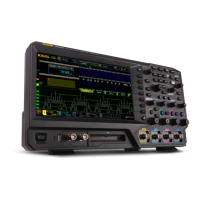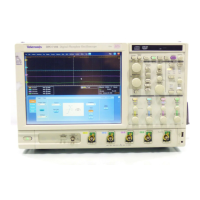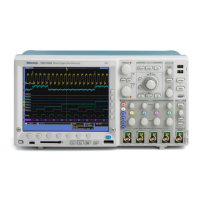Commands Listed in Alphabetical Order
Examples
MATH3? might re
turn
MATH3:POSITION 1.59400000000+001;
SCALE 1 .00000000000–00 1;DEFINE "C3+C3/C3";UNITS "V";
FILTER:RISETIME 1.00000000000-OO9;M ODE CENTERED; MATH3NUMAVG
2
.
MATH<x>:DEFine
This command allows you to define new waveforms using mathematical
expressio
ns. Sending this command is equivalent to selecting a math waveform
(M1 through M8) and entering a math expression in the Define Math dialog box.
The query form of this command returns the math definition for the specified
math waveform.
You can specify a math expression from w aveforms, measurements and scalar
sources, functions, operators, and numerical constants. You can define and display
up to eight math waveforms simultaneously.
Math expressions can be simple, such as C1, which specifies that a waveform
should show the signal source of Channel 1 with no mathematical computation.
Math expressions can a lso be complex, consisting of 100 plus characters and
compr
ising many sources, functions, and operands. As an example, you can enter
the expression Log(C1+C2), which specifies that the signals from Channels 1 and
2 are to be algebraically added, and the base 10 log of the sum is to be shown
as the final math waveform.
For detailed information about constructing ma t hematical expressions, refer to the
online h elp for this instrument.
Group
Math
Syntax
MATH<x>:DEFine <QString>
MATH<x>:DEFine?
Related Commands
SELect:MATH<x>
Arguments
QString is the mathematical expression that defines the waveform.
Examples
MATH2:DEFINE "C1+C2" adds the Channel 1 waveform and Channel 2
waveform, and stores the result in Math 2.
MATH1:DEFINE? might return MATH1:DEFINE "C2*R2" as the expression that
defines Math 1.
2-216 DSA/CSA/TDS8X00/B Series Programmer Manual

